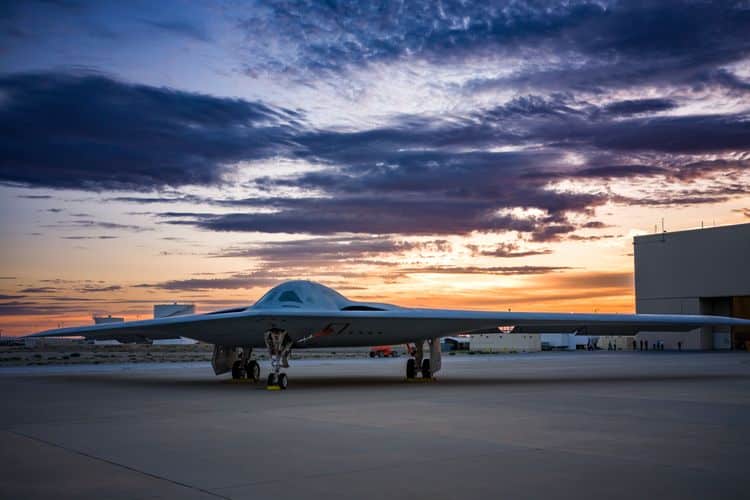Aerospace
B-21 Raider takes first flight. Nuclear stealth bomber Price, Operating cost and Features

The highly anticipated inaugural flight of the B-21 Raider, the United States’ next-generation bomber, has been successfully completed. This futuristic “flying wing” bomber represents the successor to the long-serving B-2 bomber in the U.S. Air Force’s arsenal.
The milestone flight took place at Edwards Air Force Base, with the B-21 Raider accompanied by a dedicated fighter aircraft serving as a chase plane to ensure the safety and oversight of this historic event.
B21 is estimated to be around $750 million.
An official spokesperson from the United States Air Force has verified that the B-21 Raider has entered the critical phase of flight testing, following its public debut in December 2022.
This cutting-edge aircraft carries a substantial price tag, estimated at $750 million each. It’s important to note that certain cost details are classified by the Air Force, making it challenging to validate the proposed costs.
B1, B2 Operating expense is $65,000
The U.S. Air Force’s ambitious plan involves acquiring a minimum of 100 of these advanced bombers to gradually replace the aging B-1 and B-2 aircraft.
This move is driven by the considerable operating expenses of the current fleet, with the B-1 costing approximately $60,000 per hour and the B-2 around $65,000 per hour, according to data from the Pentagon.
The B-21 Raider represents a significant leap forward in the United States arsenal of long-range nuclear-capable stealth bombers, proudly developed by Northrop Grumman.
The B-21 Raider, a product of more than three decades of innovation in strike and stealth technology, represents the next generation of the U.S. Air Force’s strategic bomber fleet and is the world’s first sixth-generation aircraft.
The Raider offers the Air Force long-range capabilities, high survivability, and versatile mission payload options, making it capable of precise strikes in the most challenging environments globally.
Key Points about the B-21 Raider:
- Sixth Generation: The B-21 sets new standards for sixth-generation technology, featuring advanced stealth and low observable processes for easier and cost-effective maintenance. Its open architecture allows for rapid upgrades and adaptation to evolving threats.
- Partnership Approach: The B-21 Raider program reimagines traditional acquisition processes through a partnership between Northrop Grumman and the Air Force, emphasizing transparency and data sharing.
- The backbone of the Fleet: The B-21 Raider is the future cornerstone of U.S. air power, offering advanced integration of data, sensors, and weaponry for both conventional and nuclear missions.
- Production Focus: The program focuses on building a production-representative test aircraft equipped with mission systems, ensuring a smooth transition into full production.
- A Digital Aircraft: The B-21 leverages agile software development and digital engineering tools for enhanced production and sustainment practices.
- Advanced Manufacturing: Advanced manufacturing techniques are employed throughout the B-21’s lifecycle, reducing risk, enhancing efficiency, and promoting expertise in the manufacturing workforce.
- A National Team: A nationwide team consisting of over 8,000 personnel from Northrop Grumman, industry partners, and the Air Force, along with more than 400 suppliers across 40 states, collaborates on the B-21 project.
- Sustainment at the Forefront: Sustainment has been a priority from the design phase, ensuring long-term efficiency and immediate benefits.
- Global Reach: The B-21 Raider is crucial to the U.S. strategic deterrence strategy, offering advanced precision strike capabilities and being part of a larger system for various military functions.
- Continuing the Legacy: The B-21 Raider pays homage to the Doolittle Raid of World War II and its pioneering spirit, which changed the course of air superiority in the U.S. military.

Aerospace
When Ratan Tata was denied entry to the airfield at the Aero India show, he waited

During our visit to Aero India 2019, we had the unexpected opportunity to see Ratan Tata at the event, which was a thrilling moment for us. However, there was a surprising hiccup when the security staff didn’t allow him to enter due to a lack of a security pass.
Despite this, he remained calm and patiently waited for about 20 minutes until a member of the Tata team brought him the required pass, after which he calmly proceeded inside. It was a humbling sight, showcasing his composed demeanor even in such situations.
Ratan Tata ji is not only a renowned industrialist but also a trained pilot, holding a pilot’s license. In 2007, he became the first Indian civilian to fly the F-16 Falcon during the Aero India show in Bangalore—a proud moment for the nation.
His passion for aviation extended beyond flying, as he played a key role in shaping India’s aerospace industry. Under his leadership, Tata ventured into manufacturing and maintaining aerospace components while upholding its legacy of quality. Notably, Tata’s collaboration with Airbus to develop and manufacture the C295 aircraft is a testament to its growing influence in the sector.
-

 Aviation2 months ago
Aviation2 months agoMicrosoft Flight Simulator Raises $3 Million to Bring Back the An-225 Mriya
-

 Airlines2 months ago
Airlines2 months agoQatar Citizens Can Travel to the United States Without a Visa
-

 Aviation2 months ago
Aviation2 months agoQatar Airways bans these new Electronic Devices on plane
-

 Airlines2 months ago
Airlines2 months agoJapan Airlines Rolls Out Free Domestic Flights to International Passengers
-

 Defence2 months ago
Defence2 months agoWhich Country Has the Largest Fleet of Fighter Aircraft?
-

 Travel2 months ago
Travel2 months agoQatar Airways Launches Four Additional Flights from Amsterdam
-

 Airport2 months ago
Airport2 months agoWestern Sydney Airport Welcomes Its First Plane After 6 Years of construction
-

 Airlines4 days ago
Airlines4 days agoDAMAC Air: Dubai’s New Luxury Airline Offers Free Flights for Registration








